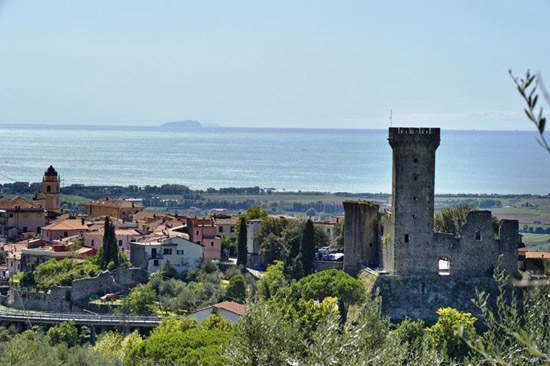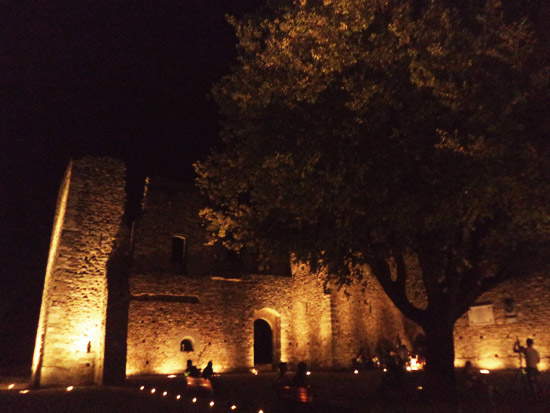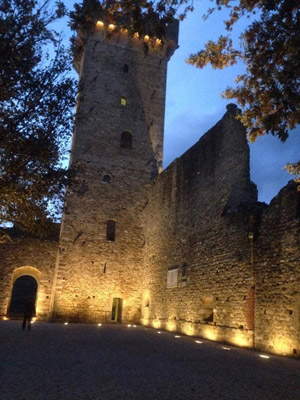The Tower of the Castle of the Bishops of Luni in Castelnuovo Magra, a place rich in history again usable
In the lands of Luni, among rolling hills filled with olive groves and vineyards, rises the small medieval village of Castelnuovo Magra, dominated by the tall tower of the Castle of the Bishops of Luni. Remember. We mentioned it a few days ago when we told you about Icons, Elliot Erwitt’s photography exhibition, set up right inside the Tower, and which will remain open until October 11. And it is just about the ancient Tower that we want to talk to you today!
 |
| A beautiful view of Castelnuovo Magra with the Ligurian Sea in the background. Photo taken from the official Facebook page of the Tower of the Bishops of Luni. |
The building, along with some fragments of the perimeter walls and another lower circular tower, is what remains of the castle, dating back to the second half of the 13th century and built at the behest of Enrico da Fucecchio, bishop of Luni who exercised his rule at the time over the area. The castle stands on the highest point of the village, where the town’s main square is today, in Piazza Querciola, and is known to have been the scene of Dante’s Peace (or Peace of Castelnuovo) that took place on October 6, 1306, between Franceschino da Mulazzo, Marquis Malaspina, and Antonio Nuvolone da Camilla, bishop of Luni: during this historical event Dante Alighieri, in the capacity of procurator of Marquis Malaspina, had the respective parties sign the peace treaty to end a seven-year war between the marquises and the bishops, who governed two territories bordering each other, with areas often disputed between the parties. A plaque affixed to one of the tower’s walls commemorates the event, which is also re-enacted every year in the summer. The tower, also referred to as Turris Magna, or Great Tower, was the castle’s main building. The latter fell into decay after the end of the wars: having exhausted its defensive functions, with the passing of the centuries the inhabitants began to demolish it in order to obtain stones to build the houses and churches of the village. This habit, unthinkable to us, but which in ancient times was quite normal, went on until the 19th century and reduced the castle to nothing more than a ruin.
 |
| The castle at night |
 |
| The Turris Magna. Photo taken from the official Facebook page of the Tower of the Castle of the Bishops of Luni. |
But after a century of neglect and closure, as of this year the castle has been returned to the citizens of Castelnuovo and the world: in particular, the very Tower, thanks to a careful recovery, restoration and consolidation project and the subsequent year-long renovation work, is now open again and has become a venue for exhibitions. It cannot be said, therefore, that the setting of the events held there and will be held there in the future is not important, as well as evocative, thanks to the castle’s play of light and shadow that make the atmosphere enchanting. The Tower, with its eighty-meter height, presents itself majestically to our eyes: the imposing quadrangular structure, with its crowning battlements supported by corbels (the supporting brackets), is also recognizable from the floor. Inside, we immediately notice the care and uniqueness with which the renovation work was carried out.
The exhibitions held there run along the entire length of the tower: there are six floors accessed by stairs made of chestnut wood. As soon as one faces the entrance to the tower, one perceives how steep this narrow-stepped staircase is, and the gradient increases from floor to floor, so much so that before beginning the visit there are signs that impart advice on how to behave during the ascent and warn that one must be in a good state of health to face the stairs. We immediately wondered why such a staircase was built this way. It’s quickly said: architect Nicola Galli and engineer Carlo Chioni, in drawing up the recovery project, were inspired by the original 19th-century design, conceived by architect Alfredo d’Andrade (the same as the Borgo Medievale in Turin, which we told you about some time ago), because it was considered the most suitable and appropriate for the environment in which one finds oneself. Chestnut wood is also present in the floors of each floor and in the easels on which the photographs of the Icons exhibition are placed: a continuity has even been created by perfectly matching the floorboards and the easels themselves!
When you reach the top, you can enjoy a beautiful view of the entire Luni plain. And in the evening everything is even more impressive, because from the top of the tower you can see thousands of small lights that illuminate the surrounding landscape. A sight to leave you breathless!
 |
| Panorama of the Luni plain from Querciola Square |
Warning: the translation into English of the original Italian article was created using automatic tools. We undertake to review all articles, but we do not guarantee the total absence of inaccuracies in the translation due to the program. You can find the original by clicking on the ITA button. If you find any mistake,please contact us.



























